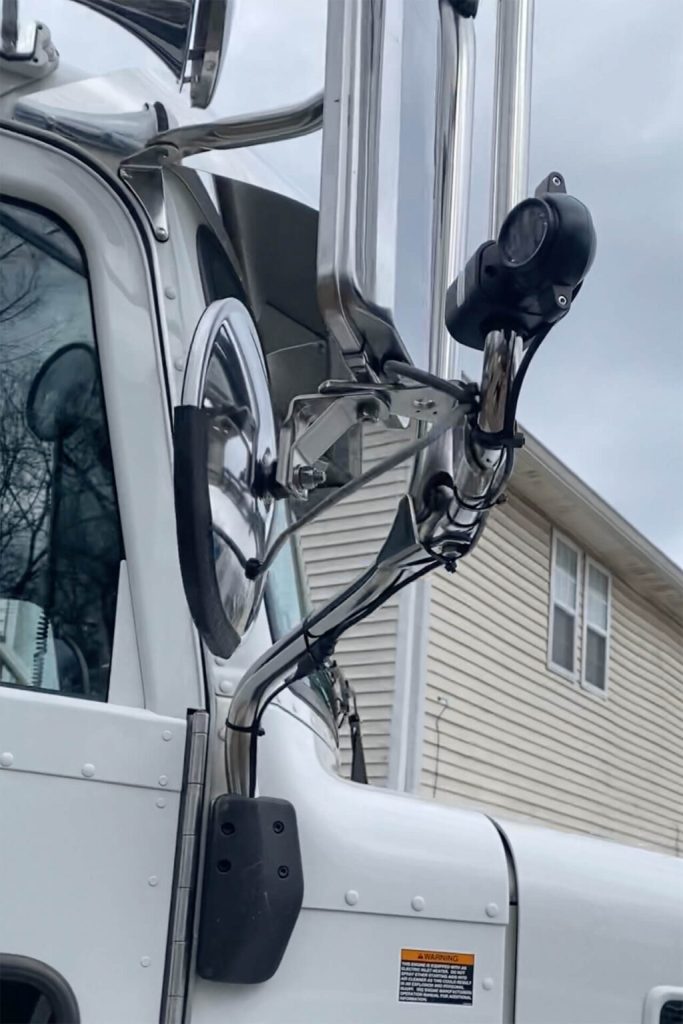

Mastering your mirrors is paramount for safe truck driving. Driving a large truck presents unique challenges, including significant blind spots. These blind spots can significantly reduce visibility and create dangerous situations on the road. This comprehensive guide will equip you with essential techniques to use your truck mirrors effectively, improving your situational awareness and driving safety. We’ll discuss critical adjustments, practices to follow when changing lanes, and how to effectively incorporate peripheral vision. Following these techniques, you’ll be more confident and aware on the road. This guide is structured into multiple sections, each covering a crucial element of effective mirror use for truck drivers.
Understanding Your Mirrors: A Foundation for Safe Driving
Mirror Adjustment and Placement
Precise mirror adjustment is the cornerstone of effective truck mirror use. The correct positioning maximizes your visibility, minimizes blind spots, and enhances situational awareness. Incorrect mirror adjustment can lead to accidents. Incorrect alignment and positioning creates obstacles in proper visualization. Adjust your mirrors so that the sides of your vehicle are clearly visible in the side mirrors. Your goal is to eliminate as many blind spots as possible while maintaining good peripheral vision. The most effective mirror alignment allows you to make the most of your available view, eliminating as much blind space as possible.
Utilizing Peripheral Vision
To augment the information from your mirrors, it’s crucial to incorporate peripheral vision. When you use your peripheral vision, you can see the area outside of your immediate focus. This allows you to be aware of vehicles and other potential hazards approaching from the sides of your vehicle. This technique provides you with invaluable information that might otherwise be missed by relying solely on your mirrors. Always be mindful of what your mirrors can and cannot see and utilize peripheral awareness to supplement this.
Mastering Lane Changes and Turns
Efficient Lane Changes
Maintaining consistent checks of your mirrors is critical for confident lane changes. Before initiating any lane change, carefully assess the space available in the adjoining lane. Use both your mirrors and peripheral vision to verify if the lane is clear for safe merging. Don’t rely on your mirrors alone; use your peripheral vision to see what your mirrors may not, reducing the likelihood of an accident. By employing a systematic approach using mirrors and peripheral vision, you can make safe lane changes and maintain situational awareness.
Effective Turns
Efficient turns require a multifaceted approach, combining mirror checks with peripheral vision. Before initiating any turn, conduct a thorough check of your mirrors and use your peripheral vision to take in the surroundings. This technique enhances your awareness of the area around the truck. Use the mirrors and peripheral vision to check behind the truck for cars. Make sure you have adequate space before making the turn and that there are no obstacles in your path, improving your driving safety.
Safe Driving Practices for Difficult Situations
Navigating Confined Spaces
When navigating confined spaces or tight intersections, employing a layered approach combining mirrors and peripheral vision is crucial. Make sure to adjust your mirrors to maximize visibility around your truck. This technique can be more effective than solely relying on peripheral vision. In confined areas, frequent mirror checks, including your side and rearview mirrors, can provide a more detailed view of your surroundings, ensuring no blind spots obstruct your vision. This will greatly reduce the risk of accidents or collisions with other vehicles.
Driving in Traffic
Maintaining a keen awareness of your surroundings is crucial while driving in traffic. In heavier traffic, frequent, consistent checks of your mirrors should be part of your routine. Regular checks help you avoid sudden lane changes or obstacles by ensuring you have a complete view of the vehicles around you. In busy traffic, it’s essential to use mirrors in conjunction with your peripheral vision, to provide a more detailed view and improve driving safety.
Advanced Techniques for Enhanced Safety
Utilizing Technology
Consider utilizing advanced technologies like blind-spot monitoring systems to enhance your awareness of surroundings. These technological tools act as an extra layer of protection and support, improving your driving safety. These systems can notify you of vehicles in your blind spots, helping you to make safer lane changes and maneuvers. Understanding your vehicle’s capabilities will improve the use of available technologies.
Practice Makes Perfect
Mastering your mirrors isn’t an overnight process. Regular practice is key to internalizing these techniques and making them second nature. Practice mirror use in different driving conditions, such as changing lanes or making turns in various traffic situations. Consistent practice will enhance your mirror skills. This will make navigating even complex driving situations easier and safer.
Maintaining Consistency and Awareness
Regular Mirror Checks
Maintaining a regular schedule of mirror checks throughout your drive is key to maintaining an accurate and updated awareness of your surroundings. This will allow for better situational awareness. Don’t just check your mirrors occasionally; check them frequently, particularly during turns and lane changes. Regular checks create an environment of improved awareness and safety.
Staying Alert
Staying alert and focused is vital for safe driving. Avoid distractions to ensure that you maintain awareness of your surroundings. Distractions, including phone use and other non-driving-related activities, can lead to unsafe driving practices. Focus on the road and your surroundings to avoid dangerous and costly mistakes.
Mirror Adjustments for Different Vehicles
Specific Truck Configurations
Understanding the specific configuration of your truck is crucial to optimizing your mirror adjustments. Different truck models and types have varying mirror setups. Each model’s setup can impact your visibility and require different mirror adjustments for the best results. Different mirror layouts affect the driver’s ability to see clearly. Understanding your vehicle’s setup can save you from avoidable incidents. Adapt your mirror adjustment to the specific layout of your truck to maintain safety.
Different Driving Conditions
Adjustments should also vary depending on the road conditions and traffic. For example, if you’re driving in heavy traffic or navigating narrow roads, adjustments may need to be more frequent and precise. When visibility is reduced, adjustments need to be made to address reduced visibility.
Additional Tips for Avoiding Accidents
Mirror Placement and Angle
The angle and placement of mirrors directly impact visibility and the effectiveness of mirror use. Maintaining the right mirror position enhances your ability to maintain visibility. Proper mirror positioning maximizes your visibility, improving situational awareness and mitigating hazards.
Regular Vehicle Maintenance
Ensuring regular maintenance of your truck, including the mirror components, is crucial for optimal performance. Maintain your mirrors. Malfunctioning mirrors can severely impact your situational awareness and driving safety. Inspect your mirrors for any damage or debris to ensure they offer optimal visibility.
The Impact of Mirror Use on Safety Statistics
Statistical Analysis of Accidents
Studies show a strong correlation between proper mirror use and a decrease in accidents. Drivers who frequently use their mirrors and pay attention to their peripheral vision are statistically less likely to be involved in accidents. This demonstrates the importance of focusing on mirror use.
Reducing Blind Spots
Proper mirror use directly reduces blind spots, improving a driver’s field of vision. By understanding how your mirrors work in conjunction with your peripheral vision, you are reducing the blind spots around you. This creates safer driving conditions and helps reduce incidents.
Professional Guidance and Resources
Driving Schools
Consider enrolling in truck driving schools that offer instruction and practice on various driving scenarios, including efficient use of mirrors and peripheral vision. Consider using external resources, such as courses that teach specific techniques, like mirror use.
Online Resources
Leverage online resources for in-depth explanations and supplemental guidance. Use available online videos, articles, or forums focusing on truck mirror use to expand your knowledge and skills. Combining in-person training with online resources allows for a well-rounded and effective learning experience for better mirror techniques.
Frequently Asked Questions
What are the most common mistakes truck drivers make when using their mirrors?
Many truck drivers fail to consistently adjust their mirrors to effectively manage blind spots and provide adequate peripheral vision. Another common error is relying solely on their mirrors for every maneuver without also utilizing their peripheral vision. Truck drivers sometimes also neglect to adequately check their mirrors before lane changes and making turns. Proper mirror adjustment and consistent practice can help avoid these issues. Regular mirror checks, particularly before lane changes and turns, along with incorporating peripheral vision, can mitigate these mistakes significantly.
How can I improve my truck mirror adjustment technique?
Improving your truck mirror adjustment technique involves a combination of understanding the functionality of your mirrors and practicing consistent use. Start by thoroughly understanding how your specific mirror system functions and the way it affects your visibility. Then, try practicing proper mirror adjustments in different driving scenarios, and pay attention to your peripheral vision to augment the information obtained from your mirrors. Consistent practice, paying attention to blind spots, and adjusting your mirror positions according to your driving needs and the truck’s layout is key to mastering your truck mirrors.
How can I use my mirrors effectively during lane changes?
During lane changes, it’s crucial to maintain consistent mirror checks. Before and during your lane change, use the right side view mirrors for visual confirmation of your surroundings in the adjacent lane. Proper mirror use reduces the likelihood of collisions and improves safety. Use your mirrors along with your peripheral vision for a comprehensive view to aid in lane changes.
In conclusion, mastering your truck mirrors is a crucial aspect of safe and effective driving. By employing the techniques discussed throughout this guide, you can significantly enhance your situational awareness, reduce blind spots, and boost overall driving safety. Remember to practice regularly and adapt these strategies to your specific vehicle and driving conditions. For continued improvement, consider taking a professional driving course focusing on truck-specific maneuvers. Now, go out there and drive confidently knowing you’ve mastered your mirrors!